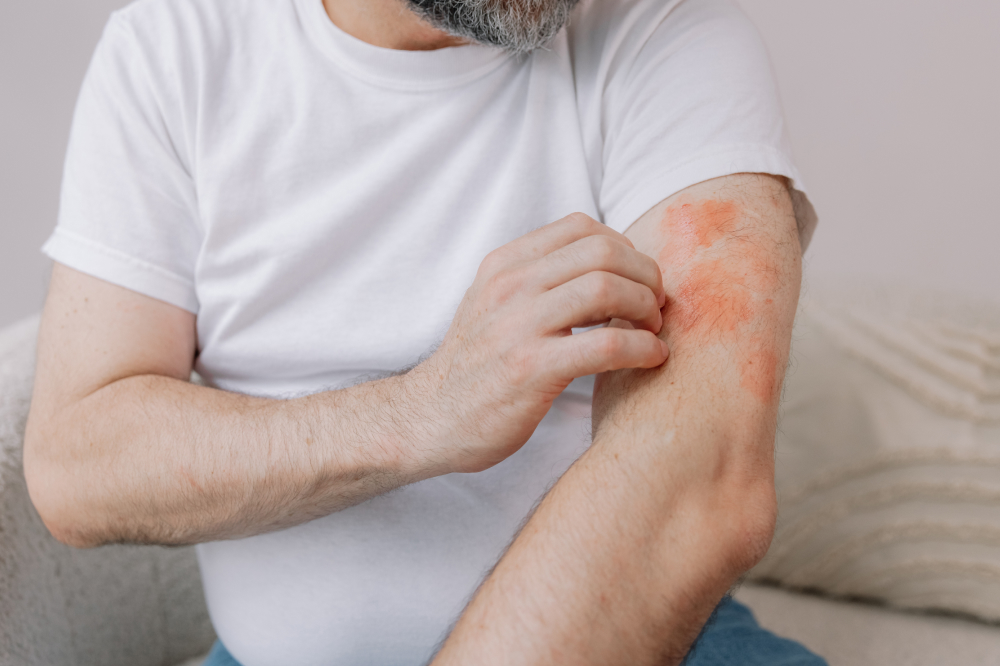3 ways for managing eczema symptoms

Eczema or atopic dermatitis is a condition in which the skin becomes inflamed, red, and itchy. This condition can also lead to leathery skin over time and patches that bleed or ooze transparent fluid. It is difficult to control the various eczema symptoms if you are unaware of the right treatment options, nutrition and remedies. So, here’s a look at some of the ways in which this illness can be managed:
Treatment options and prevention of eczema
There are several prescriptions that individuals can be recommended based on the severity of their case and certain other criteria:
DUPIXENT®
This is an FDA-approved treatment option for adults and children who are 6 months-5 years of age. It is used when other options to control the symptoms of moderate to severe atopic dermatitis have not worked out or for those who cannot use other topical therapies on the skin. However, DUPIXENT® can be used with or without the use of topical treatment options as well.
CIBINQO®
CIBINQO®, a JAK1 inhibitor, is an FDA-approved option for managing eczema symptoms in adults. This is an oral treatment option for adults with moderate to severe atopic dermatitis whose condition cannot be controlled via other prescription options. The treatment plan depends on the health professional and how the patient responds to it.
Health insurance plans may cover the cost of CIBINQO®, so one should check the policy coverage and qualifying criteria. Further, a CIBINQO® Copay savings card can help one bring down the cost of the treatment option to $0, given that one meets the eligibility criteria.
RINVOQ®
Upadacitinib, sold under the brand name RINVOQ®, is used to treat moderate to severe eczema symptoms in adults and children who are 12 years or older. It is an oral treatment option shown to relieve several eczema symptoms. Individuals observed rapid and significant skin clearing after taking upasacitinib in about 16 weeks of the treatment plan.
EUCRISA®
A topical treatment option, this is safe to use by adults and even babies who are 3 months of age and older. Using this topical treatment helps reduce skin inflammation as it acts as an inhibitor of the PDE4 enzymes that cause this irritation.
Phototherapy
This treatment plan uses artificial ultraviolet rays, specifically UVB rays. These UVB rays are then beamed onto the skin, which helps keep the inflammation and irritation at bay for most eczema patients.
Moisturizers
Frequently moisturizing the skin and keeping it hydrated is one of the prevention tips that can immensely help manage the symptoms of eczema. Dry, flaky skin will lead to more irritation and itchiness. Ask your dermatologist for recommendations, and always keep a skin-safe moisturizer handy.
Stay away from pollutants
While it is impossible to fully avoid environmental pollutants, protecting yourself as much as possible is important. Constant exposure to dust, smoke, and other air pollutants can harm the skin considerably. Wear skin-friendly masks and sunscreen as advised to shield yourself from harmful elements.
Use a humidifier
Since eczema-prone skin has the tendency to dry out, leading to irritation and flakiness easily, it might be a good idea to invest in a humidifier for your room or the entire home. This will keep the air from drying out completely and help in keeping the skin slightly hydrated.
Foods to manage eczema symptoms
Following a strict meal plan can go a long way in managing the symptoms of eczema in both adults and children. It is important to get children to understand their food triggers and teach them the value of the right nutrition early on to make management easier.
Fatty fish
This contains high levels of omega-3 fatty acids, which are a wonder for the skin due to their anti-inflammatory properties. Add fish like salmon, mackerel, tuna, and sardines. They all are rich in essential fats that are important in keeping skin healthy. If you do not like fish, you may look for omega-3 supplements that might be helpful.
Probiotics
These are one of the essential forms of nutrients needed to manage eczema. As is well known, our gut has millions of microbes that need to be fed. Prebiotics and probiotics keep these live cultures in the gut healthy and happy, which, in turn, helps build a strong immune system. A strong immune system is responsible for fighting off diseases and several allergic reactions in the body, including eczema. This will also help fight off inflammation and flare-ups that cause itchiness and irritation. Add foods like miso soup, kefir, fermented pickles, yogurt, sourdough bread, tempeh.
Foods with anti-inflammatory properties
Kale, spinach, broccoli, apples, and cherries are all anti-inflammatory foods that can help manage eczema symptoms. These are also foods that are known for their antioxidant properties, making them a healthy choice for daily nutrition. You can also add sweet potatoes and bananas to your meals.
Foods to avoid with eczema
Dairy is one of the leading causes of skin inflammation and can worsen the symptoms of eczema. Dairy and dairy byproducts, such as milk and cheese, must be avoided to manage the condition’s symptoms adequately. Additionally, foods like wheat, peanuts, milk, and soy are known triggers of eczema, especially in babies and children.
Lifestyle changes and remedies for eczema
Short showers
Short showers with lukewarm water will help you keep your skin from drying off easily. Hot baths worsen the symptoms of eczema and should be avoided.
Eczema-friendly products
Always ensure that these products do not have any harsh chemicals when buying soap, detergent, washing powder, or liquid. Choose options with mild ingredients or make your DIY natural cleanser using soaked soap nuts and water.
Bleach baths
If you prefer taking long baths, consider this option. Take about ½ cup or 118 milliliters of household bleach. Add this to 40 gallons or 151 liters of water in the bathtub. Soak yourself from the neck below for about 10 mins to calm your skin. Always use mild bleach and not the concentrated type for this bath.



